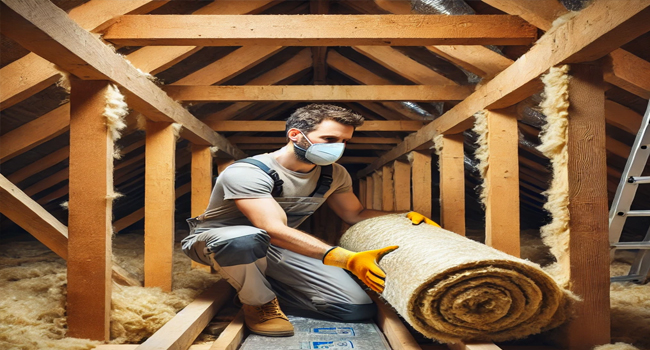Why Attic Insulation Replacement is Important
Attic insulation plays a critical role in maintaining energy efficiency and home comfort. Over time, insulation deteriorates due to age, moisture damage, pests, or mold growth, leading to higher energy bills and poor temperature regulation. Replacing old insulation with high-quality materials ensures better heat retention, improved air quality, and long-term energy savings.
If you’re wondering how much it costs to replace insulation in an attic, this guide provides detailed pricing insights, best insulation options, and key benefits of upgrading your attic insulation.
Factors Affecting the Cost of Attic Insulation Replacement
1. Type of Insulation Material
The cost varies depending on the type of insulation chosen. Fiberglass, cellulose, spray foam, and mineral wool have different price points and insulation performance levels.
2. Size of the Attic
A larger attic requires more materials and labor, increasing the total cost. The cost is typically measured in square feet, so having an accurate attic size estimate is crucial.
3. Labor and Installation Fees
Hiring a professional to remove old insulation and install new material adds labor costs, which depend on your location and project complexity.
4. Removal of Old Insulation
If existing insulation is contaminated with mold, pests, or asbestos, additional removal costs apply.
5. Energy Efficiency Goals
Higher R-value insulation materials (better thermal resistance) tend to be more expensive upfront but offer greater long-term savings.
Average Cost of Replacing Attic Insulation
The cost of replacing attic insulation varies based on the factors above. On average, homeowners can expect the following:
- Fiberglass Batt Insulation: $1.50 – $3.50 per square foot
- Blown-In Cellulose Insulation: $1.00 – $2.50 per square foot
- Spray Foam Insulation: $3.00 – $7.00 per square foot
- Mineral Wool Insulation: $2.00 – $5.00 per square foot
For a 1,000 sq. ft. attic, total replacement costs range from $1,000 to $7,000, depending on insulation type and labor.
Best Insulation Options for Attic Replacement
1. Owens Corning R-38 Fiberglass Batt Insulation
Owens Corning fiberglass batts are a cost-effective and easy-to-install option for attic insulation replacement.
- Features:
- Pre-cut batts for quick installation.
- High R-value for excellent thermal performance.
- Fire-resistant and moisture-resistant properties.
- Use Case: Best for homeowners looking for an affordable and DIY-friendly insulation solution.
2. Greenfiber Blown-In Cellulose Insulation
Greenfiber’s cellulose insulation is eco-friendly and highly effective in reducing heat loss.
- Features:
- Made from 85% recycled materials.
- Provides superior soundproofing.
- Resistant to mold and pests.
- Use Case: Ideal for homeowners who prefer sustainable, high-performance insulation.
3. Spray Foam Insulation by Icynene
Icynene spray foam expands to fill gaps and cracks, providing maximum insulation efficiency.
- Features:
- Air-sealing properties for preventing drafts.
- Reduces moisture buildup and mold growth.
- Provides long-lasting performance.
- Use Case: Best for homeowners wanting premium insulation with air-sealing benefits.
4. ROCKWOOL Comfortbatt Mineral Wool Insulation
ROCKWOOL mineral wool insulation provides excellent fire resistance and soundproofing.
- Features:
- Withstands temperatures over 2,000°F, enhancing fire safety.
- Highly resistant to moisture and mold.
- Excellent for thermal and sound insulation.
- Use Case: Ideal for homeowners looking for fire-resistant and soundproof insulation.
5. Reflectix Radiant Barrier Insulation
Reflectix insulation is a lightweight, reflective barrier that prevents heat transfer.
- Features:
- Aluminum foil layers that reflect radiant heat.
- Easy DIY-friendly installation.
- Helps in reducing attic cooling costs.
- Use Case: Best for hot climates where radiant heat control is necessary.
Benefits of Replacing Attic Insulation
1. Lower Energy Bills
Replacing old insulation reduces heat loss in winter and heat gain in summer, significantly lowering heating and cooling costs.
2. Improved Indoor Air Quality
New insulation prevents mold, allergens, and dust, leading to cleaner air circulation.
3. Enhanced Home Comfort
Proper attic insulation eliminates drafts and uneven temperatures, making your home more comfortable year-round.
4. Increased Property Value
Energy-efficient homes with proper insulation are more attractive to buyers, boosting resale value.
5. Reduced Carbon Footprint
High-quality insulation decreases energy consumption, contributing to a more sustainable home.
How to Replace Attic Insulation
1. Inspect Existing Insulation
Check for signs of mold, water damage, or pest infestations before replacing old insulation.
2. Remove Old Insulation
- Fiberglass and cellulose insulation can be vacuumed or bagged for disposal.
- Spray foam insulation requires professional removal.
3. Install New Insulation
- Roll out fiberglass batts or blow in cellulose insulation.
- Spray foam insulation requires professional application.
4. Seal Gaps and Ventilation
Ensure proper attic ventilation to prevent moisture buildup and maximize insulation efficiency.
Where to Buy Attic Insulation
- Home Depot: Shop Attic Insulation
- Lowe’s: Find Insulation Products
- Amazon: Buy Insulation Materials
Frequently Asked Questions
1. How often should attic insulation be replaced?
Attic insulation lasts 15–25 years, but replacement is needed if damaged by moisture, pests, or aging.
2. Can I replace attic insulation myself?
Yes, fiberglass batts and blown-in cellulose are DIY-friendly. Spray foam requires professional installation.
3. What is the best insulation for attic replacement?
The best option depends on climate, budget, and energy efficiency goals. Spray foam provides superior insulation, while fiberglass and cellulose offer affordable and effective alternatives.
Upgrading your attic insulation is an investment that pays off in energy savings, comfort, and home value. By choosing the right insulation type and installation method, you can enjoy a more efficient and comfortable home for years to come.
